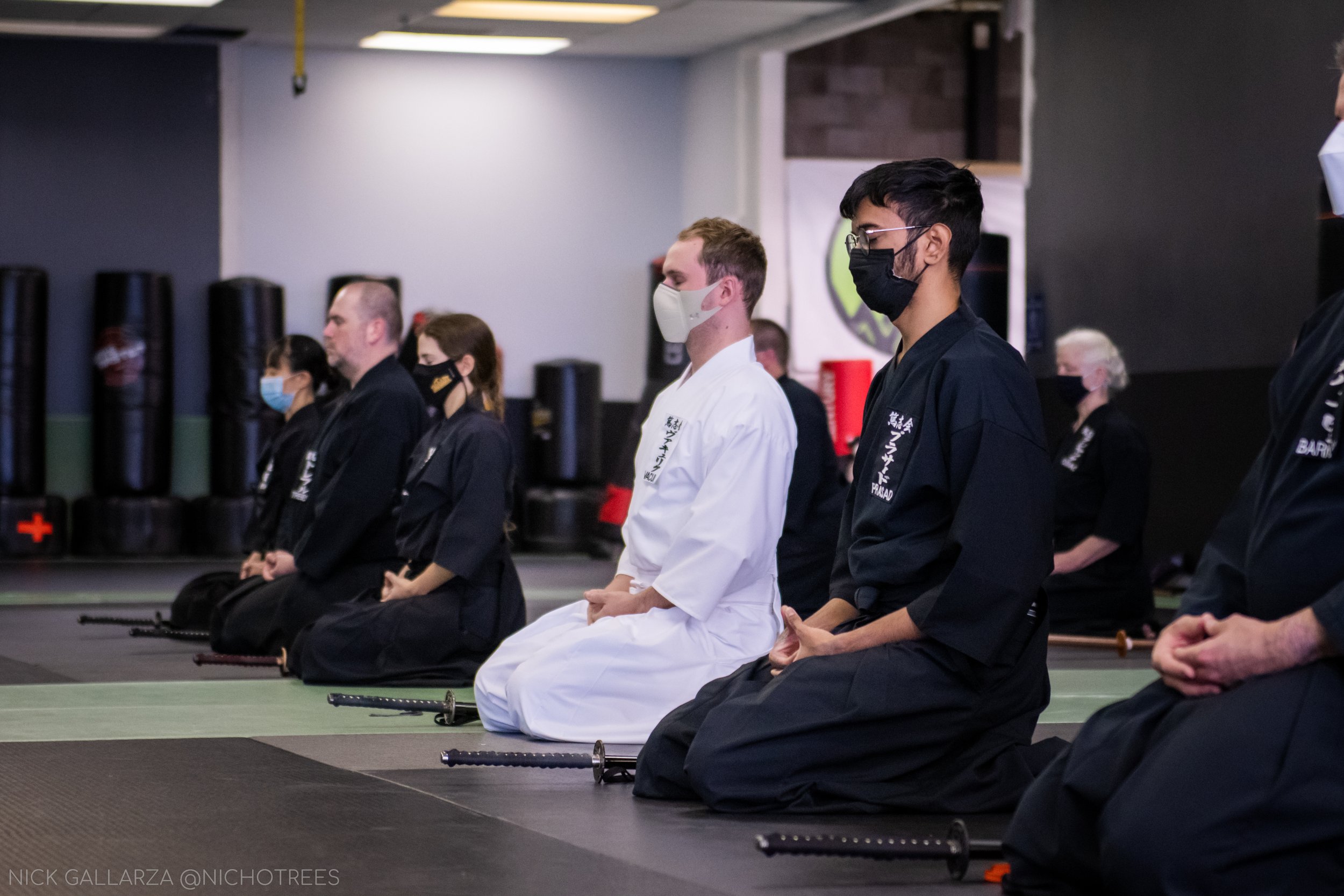
What is Iaido?
Iaido is the art of sword drawing, and belongs to a family of traditional Japanese martial disciplines, including Kendo, Kyudo, Naginata, and more.
居合道
居合道は、日本刀の操法に
由来するものであり、室町時代に
その起源があるといわれます。
勝負を抜刀の
一瞬にかける居合道の修業は、
死生一如、動静一貫をめざす
心身鍛錬の道となっており、
剣道と表裏一体の関係にあります。
Iaido is derived from the fundamental usage of the Japanese sword, and originated during the Muromachi period.
The practice of Iaido is to achieve victory at the instant the sword is drawn — where life and death are one and the same.
Iaido is a way of training the body and mind such the stillness and movement are consistently balanced, and shares a two-sided relationship with the art of Kendo.
Where does “Iaido” come from?
The term IAI comes from a Japanese phrase "Tsune ni ite, kyu ni awasu" roughly translated as “Existing naturally in the moment, ready to face any eventuality”
For this reason, the techniques used are interpretations of different situations, and hypothesize scenarios in which there are enemies in variable numbers and in the most disparate places such as a room in the dark, a bridge, a narrow alley etc.
It is said that the essence of iaido is "Saya no uchi" which originates from the phrase "Saya no uchi de katsu".
Both mean the victory lies in the scabbard of the sword, therefore in winning without the need to unsheath. In short, being able to surmount the opponent with his own ki before even letting the sword out of the saya, and therefore make him desist from any type of intention of attack.
Like other martial arts of Zen derivation, iaido is not a combative discipline but is designed to cultivate one's spirit and has as its real objective the development and training of one’s character.
Through practice of the sword, one refines one's spirit, and aims to become a better person, seeking peace and friendship within the dojo and within one's everyday life.
How does one practice Iaido?
Iaido is is practiced through the execution of kata — codified forms of combat, which are performed alone, or rather, against an imaginary opponent.
A kata of iaido consists of several stages. Normally it begins with an opening draw-cut followed in rapid succession by one or more decisive movements, depending on how many opponents are hypothesized. The conclusion of a kata involves the cleaning of the blade and the re-sheathing of the sword. All this without ever losing sight of the imaginary opponent.
The above is based on the definition of Iaido | Japanese martial art using Katana (kiryoku.it)

What styles of Iaido are practiced at Tokushikai Canada?
Tokushikai members practice Muso Jikiden Eishin Ryu via our Sensei, Atsumi Hatakenaka (Hanshi 8-Dan). Our regular practice includes the primary 4 sets within MJER, including Omori Ryu, Eishin Ryu, and three sets of Oku Iai.
We are also members of the Canadian Kendo Federation, an affiliate of the International Kendo Federation and All Japan Kendo Federation (Zen Nippon Kendo Renmei, ZNKR). As such, we practice the style standardized by the ZNKR, often referred to as “Seitei” or “Zen Ken Ren Iai (ZNKI)”. This set of techniques are predominantly used for tournaments and examinations.
Muso Jikiden Eishin Ryu
-
前 Mae
右 Migi
左 Hidari
後 Ushiro
八重垣 Yaegaki
受流 Ukenagashi
介錯 Kaishaku
附込 Tsukekomi
月影 Tsukikage
追風 Oikaze
抜打 Nukiuchi
-
横雲 Yokogumo
虎一足 Toraissoku
稲妻 Inazuma
浮雲 Ukigumo
颪 Oroshi
岩波 Iwanami
鱗返 Urokogaeshi
波返 Namigaeshi
瀧落 Takiotoshi
真向 Makkō
-
霞 Kasumi
脛囲 Sunegakoi
戸詰 Tozume
戸脇 Towaki
四方切 Shihōgiri
棚下 Tanashita
両詰 Ryōzume
虎走 Torabashiri
-
行連 Yukizure
連達 Tsuredachi
惣捲 Sō Makuri
惣留 Sō Dome
信夫 Shinobu
行違 Yukichigai
袖摺返 Sode Surigaeshi
門入 Mon'iri
壁添 Kabezoe
受流 Ukenagashi
暇乞其の一 Itomagoi Sono Ichi
暇乞其の二 Itomagoi Sono Ni
暇乞其の三 Itomagoi Sono San
-
速浪 Hayanami
雷電 Raiden
迅雷 Jinrai
Zen Ken Ren Iai (All Japan Kendo Federation Iai)
-
前 Mae
後ろ Ushiro
受け流し Uke Nagashi
柄当て Tsuka Ate
袈裟切り Kesa Giri
諸手突き Morote Tsuki
三方切り Sanpo Giri
顔面当て Ganmen Ate
添え手突き Soete Tsuki
四方切り Shiho Giri
総切り Sou Giri
抜き打ち Nuki Uchi
